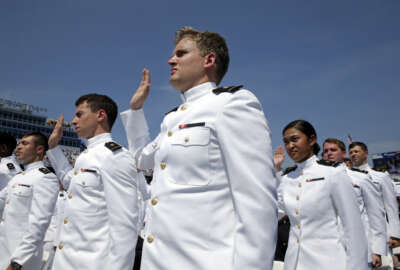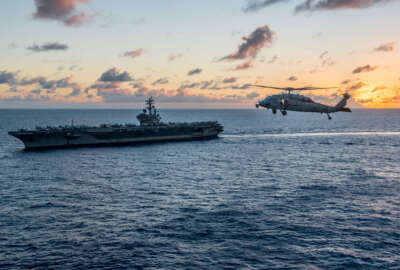
Mindful of budget constraints, Navy set to revise its aspirations for bigger fleet
The Navy’s top officer says he remains convinced that the global security landscape will demand “more Navy,” over the next few decades, but his service...
The Navy’s top officer says he remains convinced that the global security landscape will demand “more Navy,” over the next few decades, but his service appears to be tempering its appetite for exactly how much more, at least when measured in numbers of ships and people.
The Navy’s most recent force structure assessment, issued in December, calls for a fleet of 355 ships, on par with what President Donald Trump has proposed, and 80 more than it has today. Officials have acknowledged that number was “unconstrained” by budget realities.
But last week, the Congressional Budget Office released a detailed assessment of what a fleet of that size would actually cost. The Navy would need to spend $26.6 billion per year for the next 30 years, 60 percent more than its average annual shipbuilding budget over the last three decades. The personnel, fuel and supply costs involved in maintaining a fleet of that size would also be 67 percent higher than they are now, according to CBO.
Speaking just a few days after the CBO assessment, Adm. Jonathan Richardson, the chief of Naval operations, said the Navy will publish an article in the coming weeks laying out its current views on exactly how big it needs to be, and that it will be “mindful of the available resources.”
“There has been a lot of discussion about future Navy. The one thing that has been missing from that is, what do we think? There hasn’t been a strong U.S. Navy voice on that,” he said Thursday at the Brookings Institution. “We’re putting our final thoughts together about that.”
Richardson strongly suggested that, at least in the near-term, the Navy would emphasize the need to invest more in technological advances that would give it the warfighting equivalent of 355 of today’s ships without necessarily building that many hulls.
“We’ll talk about some of these innovative technologies that are really right around the corner — I mean knocking on the door — I’m not talking about something that is an idea, or unobtained right now,” he said. “There will be a capacity part of this, but there is also a capability dimension. What do you do to provide credible options to leadership? You’ve got to be there to be credible and have an option, but you’ve got to have the right capability set as well.”
The CNO’s comments came in the context of a speech in which he said the Navy needs to act with urgency on a number of fronts, from budget planning to personnel policy to acquisition reform, lest it be outpaced by its rivals, including China, which by some estimates will have a Navy larger than the U.S. by 2030.
Some of those factors, like continual delays in congressional appropriations, are outside the Navy’s control, he said.
“You’re really talking about trying to win a mile race and spotting your competition a lap,” Richardson said. “But we’re committed to doing everything we can with the resources that we get, that part that we do control to be absolutely judicious with those to make sure that we are as innovative and creative, accountable as possible with those resources.”
On personnel, he noted that the Navy has met its recruiting goals in each of the last 10 years, but said it must build a “cutting edge” personnel system to retain the people it needs most — those whose skills are in demand on the part of private employers and other public sector organizations.
“What I’m striving for is a picture of every individual sailor. What are their priorities in terms of professional development, family development, their entire life so that we can then tailor a compensation package — our best offer, if you will — to get after the competition we face,” he said. “If they want to fly around the world and be operators 100 percent of the time, I’ve got a lot of jobs like that. If they want to stabilize in a particular area to put their kids through school or something, we’ve got opportunities there. Technology enables to get at that personal level of knowledge and then to package a program to address that. We’ll probably never get a 100 percent match. But we can do better.”
On acquisition policy, he said the current system is simply too slow to meet the Navy’s needs to continually absorb new innovations, adding that even if the service somehow managed to add 80 of today’s ships to its fleet by the mid-to-late 2020s, many of them would be obsolete by then.
For the future fleet, he said he aspired to a ship design in which the most expensive parts of a vessel, their hulls and their propulsion systems, last for 30 years, but almost everything else can be replaced and upgraded every five years.
“It just takes too long to do stuff,” Richardson said. “Our industry partners operate in the commercial and government sectors, and their government business looks like it’s in a science fiction movie, where people are moving around at different time scales. It’s just so much slower. We’re working very hard with industry right now to really do a full court press on those assumptions and get things done faster. I mean, design the ship in one-third, one-half of the time that historically we’ve done. Build that thing faster.”
Return to the DoD Reporter’s Notebook
Copyright © 2025 Federal News Network. All rights reserved. This website is not intended for users located within the European Economic Area.
Jared Serbu is deputy editor of Federal News Network and reports on the Defense Department’s contracting, legislative, workforce and IT issues.
Follow @jserbuWFED





